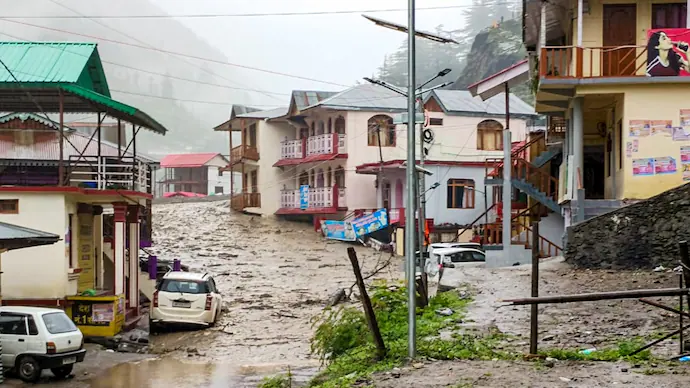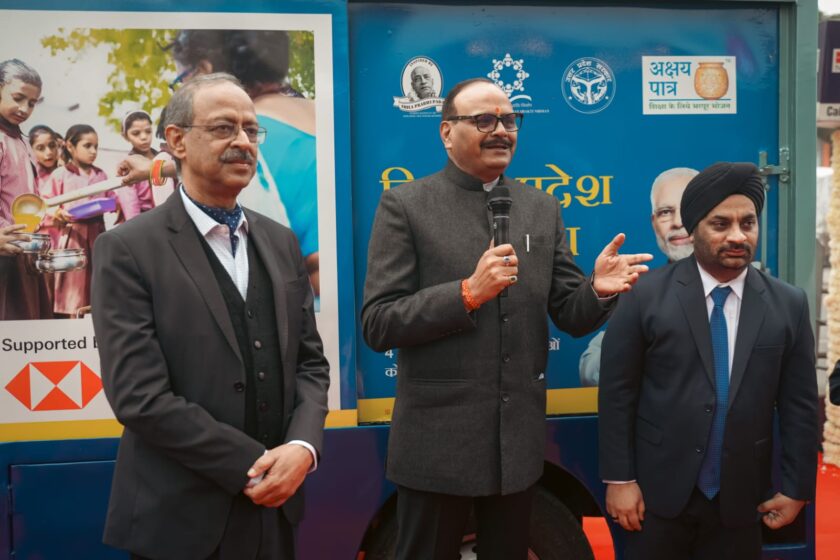
The Himalayas, often known for their stunning beauty, can be harsh and merciless due to their rugged terrain and unpredictable nature. A chilling reminder of the region’s vulnerability to natural disasters comes from the recent incident in Dharali town, a town of around 900 people in Uttarakhand’s Uttarkashi district, where a cloudburst in the Kheer Ganga catchment area led to devastating floods. Such incidents highlight the importance of respecting and understanding the power of nature, especially in a fragile ecosystem like the Himalayas.
The flash flood that hit Dharali village on the way to Gangotri on Tuesday, August 5, 2025 was a force of nature that left massive destruction in its wake. Starting around 1.30 pm, a powerful torrent of water laden with tonnes of rocks and debris swept away a large settlement in a heart-rending 47 seconds, leaving behind a trail of devastation that will take years to recover from. The speed and magnitude of this disaster has stunned everyone, and is a terrifying reminder of the immense power of the Himalayas.
The cries for help and the frantic shrieks and whistles of onlookers for warning proved of no help to the hapless residents of Dharali, who were mercilessly swept away by the fury of the flood. In one heart-chilling moment, the village vanished from existence, leaving behind a desolate landscape of stones and rubble, which has now buried all structures and spread over more than 20 acres of land where laughter, life and livelihood once flourished. The sheer scale of the destruction is staggering — more than 500 people, including two brave Junior Commissioned Officers (JCOs) and nine soldiers, are feared missing, their fate hanging in the balance. The echoes of their lives, their homes and their stories now lie buried under the rubble, a poignant reminder of nature’s brutality.
The tragedy has left deep scars on the community, with locals, migrant workers from Nepal and Bihar, and tourists staying in about thirty hotels and homestays all swept away by the gushing floodwaters. The search for the missing loved ones is ongoing and families are anxiously waiting for news of their loved ones.
In times of such a disaster, the quick response of the government in collaboration with the Army, NDRF and SDRF was of utmost importance. However, rescue and relief operations were badly affected due to incessant rains and destroyed infrastructure, roads, bridges, communication and power networks, making it a big challenge for the teams deployed on the ground.
Uttarakhand Chief Minister Pushkar Singh Dhami displayed strong leadership by personally monitoring relief operations and reaching out to the affected areas braving challenging conditions. His emotional expressions reflected the gravity of the situation when he met survivors, consoled them and assured them of full support. Key steps taken by him included coordinating with agencies such as the Army and the NDRF, announcing financial assistance for affected families, and forming a committee to monitor rehabilitation efforts. His hands-on approach and empathetic leadership have been widely appreciated, boosting the morale and confidence of the affected communities.
Although a prompt government response is both a constitutional obligation and a political necessity, the real challenge lies in learning valuable lessons from such tragic natural disasters. It is imperative to introspect and identify areas for improvement to better prepare for and tackle future disasters.
Uttarkashi, my home district, has witnessed a series of devastating natural disasters that have left an indelible mark on its history. The devastating floods of 1976, the flash floods in the Gyansu area in 1983, the earthquake that struck Jamak village, just five kilometres from Uttarkashi, in 1991, and the submergence of the Varun-Vat mountain in 2000 – all these events have taught us valuable lessons about the vulnerability of the region and the importance of preparedness and resilience.
Having witnessed these natural disasters in Uttarkashi, I have seen first-hand the devastating effects of human-induced interference with nature. The 1976 flood, triggered by the creation of an artificial lake and exacerbated by large-scale deforestation in the hills around Harshil, was a vivid example of this. The resulting flash flood raised the water level of the Bhagirathi River, which later became the Ganges, to dangerous levels, submerging towns and villages as far as Uttar Pradesh. The destruction was horrific—bridges bent beyond recognition, roads were washed away, and power and communication networks were disrupted. I still remember the horrific image of iron bridges that had been damaged like twisted rings, a testament to the fury of the floodwaters.
The flash floods at Gyansu were a tragic consequence of unauthorised settlements. The hilly terrain is extremely fragile and despite it being a prohibited area owned by the Forest Department, many migrant vegetable vendors and daily wage labourers had settled there in search of livelihood. This encroachment blocked the natural flow of a seasonal river, creating a deadly blockage. When the rains came, the flash floods swept away everything in their path and killed dozens of people. It is a devastating reminder of the dangers of ignoring environmental hazards and not respecting nature’s boundaries.
The earthquake that struck Jamak village, just five kilometres from Uttarkashi, in 1991 was devastating. The quake, measuring over 7 on the Richter scale, claimed more than 500 lives and left a trail of destruction. Government buildings developed cracks and residences of key officials, including the Superintendent of Police (SP) and the District Magistrate (DM), were severely damaged. The tragedy affected the SP personally, losing his wife and leaving most officials in shock. I remember the DM becoming hysterical and depressed as he struggled to recover from the blow. As a member of a team sent by then Chief Minister Kalyan Singh to assess the situation, I witnessed the extent of the destruction firsthand. Based on my report, the CM ordered the transfer of the DM and SP to give them respite from the trauma
Interestingly, in the earthquake epicentre, Jamak village, traditional houses made of wood, mud and small stones showed remarkable resilience and suffered significantly less damage than structures made of cement concrete. This striking difference highlights the potential benefits of incorporating traditional knowledge and materials into construction processes, especially in seismically active areas. The relative success of these traditional designs is a valuable lesson in the importance of context-specific architecture and the need to combine traditional knowledge with modern construction techniques.
The resilience of the traditional building style is further evident from the enduring architecture of my village Barsali, where five-storey houses have stood the test of time for over 300 years. These structures have withstood the seismic activities and other environmental challenges of the region, a testimony to the timeless wisdom of traditional architectural design. The fact that these have remained intact is a powerful endorsement of the effectiveness of these time-tested construction methods.
What is remarkable about these traditional constructions is that they are crafted from locally sourced materials, making them not only cost-effective but also perfectly suited to the local climate and requirements. This harmonious blend of sustainability, practicality and cultural relevance has enabled these structures to stand the test of time, a testimony to the ingenuity of traditional building practices.

Another most important aspect is that the traditional settlements situated in the higher reaches of Uttarkashi exemplify the harmonious relationship between man and nature. By staying away from the rivers, the locals have reduced flood hazards and maintained the purity of the water. This sustainable approach reflects the unique cultural and environmental dynamics of the region. However, modernization has led to a change in lifestyle and settlement patterns, and people are migrating to the slopes and roadside areas in search of better opportunities. But this change has its own price and has resulted in increased incidence of floods causing frequent loss of life and property.
As we move forward, the issue of Varunavat submergence is a serious concern for Uttarkashi district headquarters, which has a population of about three lakh. Despite knowing its sinking nature, new settlements have been built, further aggravating the problem. In 2000, Rs 300 crore was sanctioned for conservation and augmentation efforts, but locals claim massive irregularities in implementation, accusing the government machinery and politicians of misusing development funds.
As a journalist for The Times of India, I have had the opportunity to cover all the disasters mentioned above. Through my reporting, I have seen first-hand the region’s vulnerability to natural disasters and the importance of disaster preparedness and mitigation. The irony is that while there is concern and noise during these disasters,the momentum is often lost soon after, and the issues fade into oblivion.
Late Sunderlal Bahuguna’s tireless efforts to protect the Himalayas and oppose the Tehri Dam are truly commendable. His conviction and perseverance in the face of adversity is inspiring. It is extremely sad that his warnings about the potential impacts of the dam were not heeded and now Uttarakhand is suffering the consequences.
The region’s vulnerability to climate-related disasters such as cloudbursts and floods underlines the importance of listening to environmental voices such as Bahuguna’s. His legacy is a reminder of the need for sustainable development and environmental protection in the Himalayas.
The continuous pursuit of development often takes a toll on environmental sustainability, leading to frequent disasters. The construction of all-weather roads in Uttarakhand by the Border Roads Organisation (BRO) has indeed raised concerns about environmental sustainability and disaster risk. Careful planning and execution is required to reduce the risk of landslides and erosion in the fragile terrain of the Himalayas.Without adequate supporting structures, such as retaining walls, the process of cutting into mountains can leave roads unstable and vulnerable to damage during the rainy season. This not only requires frequent repairs and reconstruction, but also increases the risk of landslides and other disasters.
It is imperative to adopt environmentally sensitive and sustainable road construction techniques that take into account the specific geology and ecology of the region. Regular audits and evaluations can help identify areas for improvement and ensure that road construction is carried out in a manner that causes minimal damage to the environment and local communities.
All this requires a change in approach, for which a well-thought-out environmental policy supported by geographical data, seismic history and hydrological studies can really help in reducing the impact of natural disasters. By understanding the specific features of the region, such as seasonal water courses, dynamics of the Ganga River and other rivers like it, we can:
- Identify high-risk zones: Mapping areas prone to landslides, floods, or earthquakes.
- Inform development planning: Ensuring infrastructure and settlements are designed and built to withstand natural hazards
- Implement mitigation measures: such as early warning systems, flood-resistant construction, and suitable land use practices.
Therefore, it is imperious to strike a balance between progress and conservation. Harmonizing development with environmental practices can reduce the risk of such disasters. Community preparedness is another important aspect. By educating and empowering local communities, they can be better prepared to face emergencies.
The concern and love for the Himalayas is understandable in many ways, but the truth is that it is abundant and beautiful. Its awe-inspiring views, majestic peaks, often romanticised for their excellence, remain an eternal inspiration for everyone, from common tourists to poets and peace seekers. A wonder of the earth, the Himalayas are believed to be the abode of Shiva, who embodies truth, beauty and goodness (Satyam, Shivam, Sundaram). So, instead of exploiting it for commercial gains, it would be a good idea to love, cherish and preserve the Himalayas in its purity, like the beauty of a woman. The sunlight dancing on its snow-clad peaks in shades ranging from pale yellow to fiery red is a feast for the eyes, but it also demands our reverence and care. It is high time we understood the importance of preserving this natural wonder and avoid trampling it for short-term gains.
The writer is senior journalist and former U.P. State Information Commissioner





